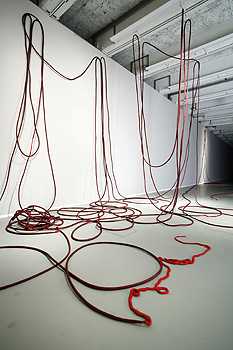Documenta,
Jun 16, 2007 - Sep 23, 2007
Kassel, Germany
Documenta 12
by Kirsten Einfeldt
Works such as And tell him of my pain (1998-2007) by the Indian artist Sheela Gowda (1957), consisting of a rope made up of 89 interwoven threads each 100 meters long, stuck together with gum Arabic and painted with saffron, provide a framework for that concept: it makes reference to an umbilical cord, to the fate of the Indian textile industry after having been colonized by the British East India Company during the eighteenth century, and through color, to Hindu tradition. In this case, Buergel’s curatorial justification, that the rope is anticipated and repeated as motif and concept in the iconography of different periods and cultures, speaks for itself: he compares it with the figure of Concord, which passes the unifying cord to public representatives in a cycle of frescoes on good and bad government by Ambrogio Lorenzetti in Sienna’s Public Palace; or the photographs of Dutch artist Lidwien van de Ven (1963), which speak of political and religious opposition movements that run counter to common sense.(2) The key problem with Documenta 12 is that for the spectator viewing the exhibition, this kind of relationships was rarely intelligible.
That strategy was effective in works such as the portraits of Afro-Americans by American painter Kerry James Marshall (1955), hung among the collection of Ancient Masters at Wilhelmshöhe Castle. From the direct opposition of oils such as The Lost Boys (1993) with paintings by the Flemish painter Karel van Mander (1606-1670) on Heliodorus’s The Ethiopian Story, viewers were able to understand the different plastic approaches of artists of different periods and latitudes, the aim of which was to appropriate motifs such as "the unknown", represented by African identities, highlighting or questioning exoticisms. In the Rembrandt Room, the sense of parody in the paintings of Polish artist Zofia Kulik (1947), made in the style of portraits of sovereigns, came to light on facing a portrait of Queen Elizabeth of Britain.
At the Fridericianum Museum, the nucleus of Documenta since its foundation in 1955, there was little relationship between the works and rooms. The few examples in which the establishment of a dialogue was achieved concerning the rediscovery of certain legendary, although forgotten, works stemming from the experimental art of the fifties and sixties. These were revealed in the neoconstructivist sculpture of the Brazilian Mira Schendel (1919-1988), and with the staging of vanguard dances by the U.S. choreographer Trisha Brown (1936). Likewise, Schendel’s constructivist concerns resonated in the dynamic installation of the Brazilian artist Iole de Freitas (1945). Topics such as performativity and the exploration of the potential of the human body within the framework of early alternative media were interpreted in a subtle but effective way. Buergel and Noack contextualized bodies in transformation in Trisha Brown’s performance on the body as the medium and the basis in Electric Dress (1956), the pre-Fluxus installation-performance by artist Atsuko Tanaka (1932-2005), a member of the still-underestimated Japanese post-war group Gutai, founded in 1954.
The formalist discourse was not echoed in other works, for example in the pictures by the Chilean Juan Dávila (1946), which questioned cultural and sexual identities, in the lyrical imaginative figments of the German painter Monika Baer (1964), or the polychromatic abstract sculptures of the American John McCracken (1934). They are part of a series of works that, on the whole, give the impression of being a sort of miscellany stemming from art warehouses appropriated by the curators.
|













